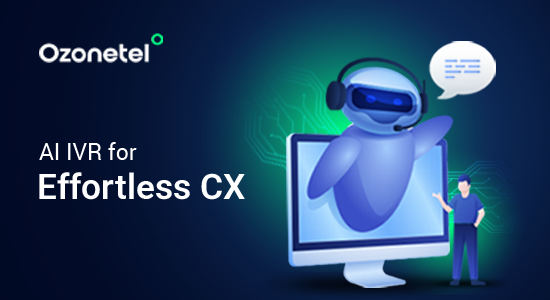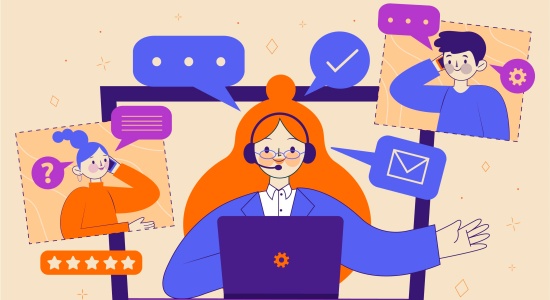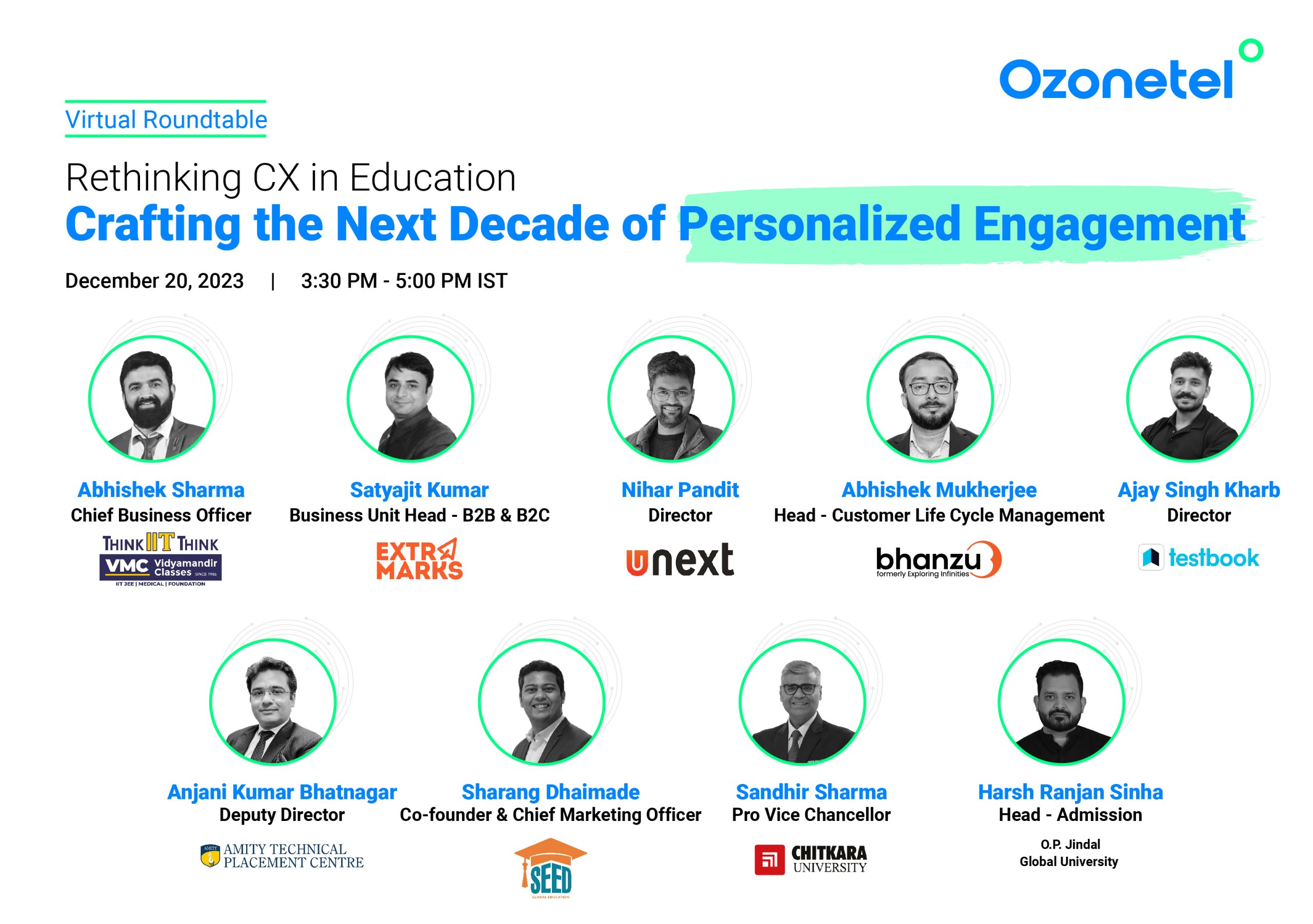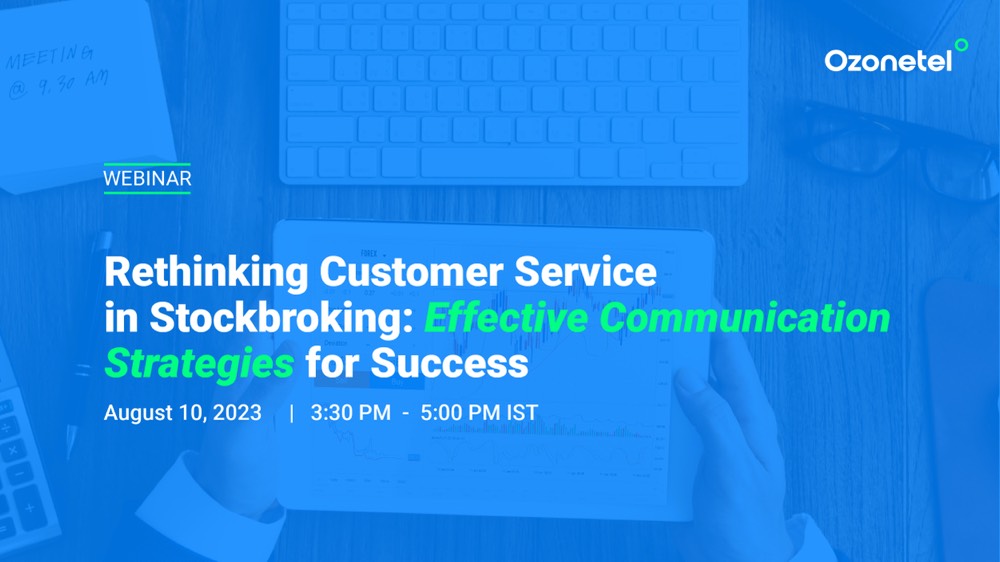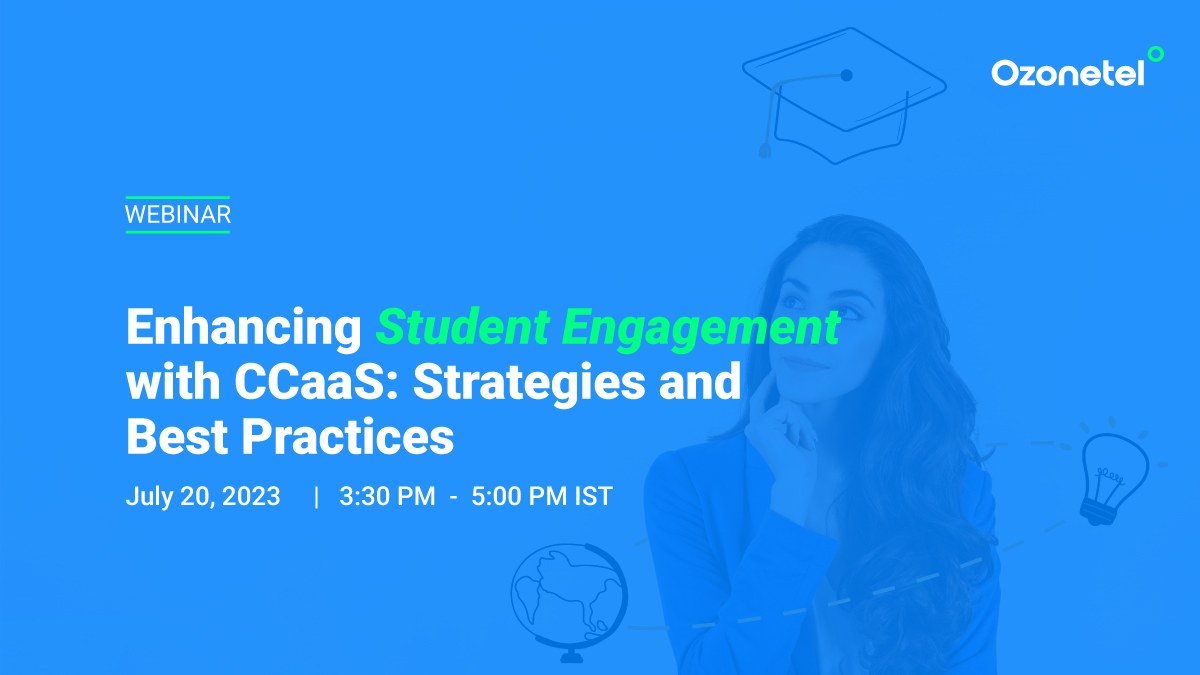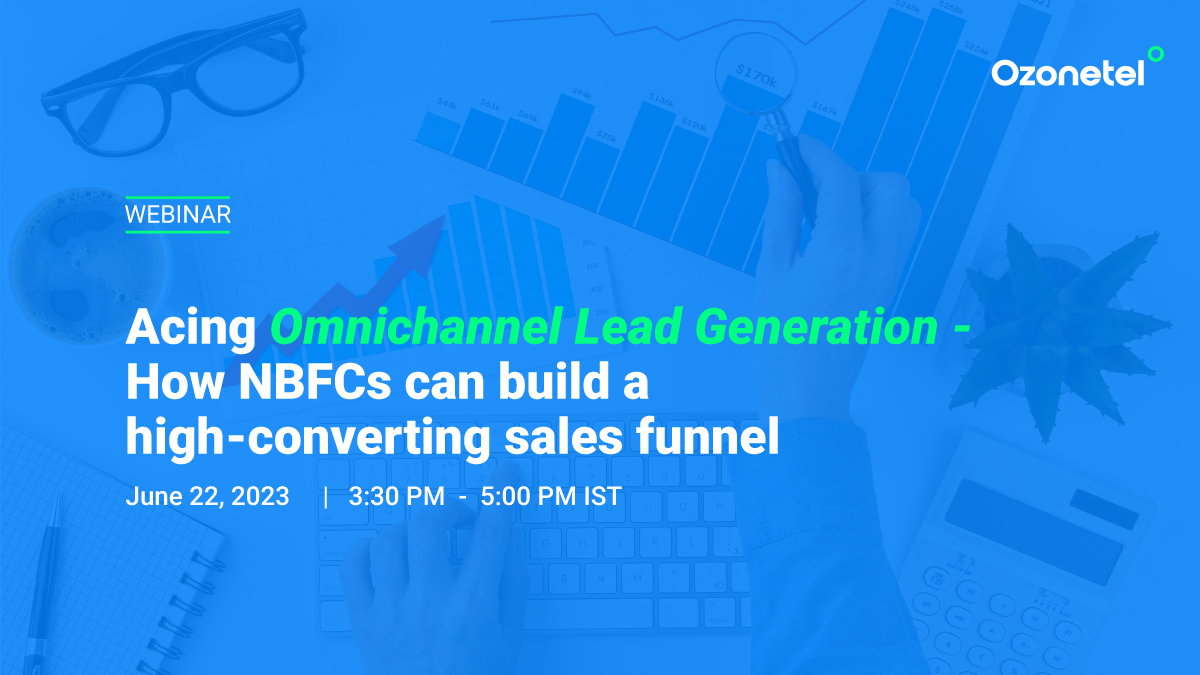- Resources
- Speech Analytics: Definition, Features, and Use Cases
Speech Analytics: Definition, Features, and Use Cases

Every day, contact centers handle hundreds or even thousands of customer calls. But without the right tools, most of these conversations go unheard when it comes to quality checks, customer insights, or agent performance tracking.
A robust Speech Analytics solution solves this problem. It records, transcribes, and analyzes customer calls—helping businesses find patterns, measure agent performance, track customer sentiment, and spot issues like missed sales opportunities or compliance gaps.
Continue reading to know more.
In this article, we will explore:
- 1.What is Speech Analytics?
- 2.Why Speech Analytics Is Important
- 3.How Speech Analytics Works
- 4.Key Features to Look For
- 5.Benefits of Speech Analytics
- 6.Speech Analytics vs Voice Analytics
- 7.Use Cases of Speech Analytics
- 8.CX Improvement Through VoC Trends
- 9.How Brands Are Winning with Ozonetel Speech Analytics
- 10.How Ozonetel Helps
What is Employee Experience?
Employee Experience (EX) is the overall perception employees have of their journey within an organization. It encompasses every interaction and touchpoint, from recruitment and onboarding to daily responsibilities, support systems, and eventual offboarding.
What is Speech Analytics?
Speech Analytics is a technology that automatically analyzes customer conversations happening over voice calls. It converts spoken words into text and uses AI to pull out key insights like customer sentiment, trending topics, agent performance, and compliance issues.
This is about understanding:
- What the customer is saying
- How they are saying it (tone, pitch, pauses)
- How the agent is responding
- Whether key sales or service scripts were followed
Why Speech Analytics Is Important
Contact centers handle huge call volumes every day. Without Speech Analytics, most conversations go unanalyzed. Here’s why that’s a problem and how speech analytics helps fix it:
1. You Can’t Improve What You Don’t Measure
Most contact centers review less than 2% of calls manually. This creates blind spots:
- Poor agent behavior goes unnoticed
- Customer complaints don’t get flagged fast enough
- Sales opportunities get missed
Speech Analytics solves this by auto-scanning 100% of conversations. For example, India’s National Health Authority (NHA) used AI-driven speech analysis to review over 1.2 million healthcare calls, far beyond what manual audits could cover.
2. Faster, Targeted Agent Coaching
Instead of giving generic feedback, managers get clear, call-specific coaching triggers like:
- “Agent did not offer a site visit.”
- “Agent interrupted the customer 4 times.”
- “Customer mentioned cancellation but agent didn’t address.”
You’re not just tracking call volume or handle time—you’re tracking behavior that affects outcomes.
3. Boost Conversion and Revenue Metrics
In sales-focused contact centers, conversion rates depend heavily on how well agents handle customer objections, build urgency, and pitch offers. Speech analytics tracks:
- If agents mention active promotions
- How frequently site visits or demos get pitched
- How agents handle price pushbacks
With these insights, you can rewrite call scripts, run targeted training, or trigger real-time nudges for agents during live calls.
4. Improve First Call Resolution (FCR) and Reduce Repeat Calls
Analyzing call patterns helps teams identify why issues don’t get resolved on the first call:
- Are agents transferring too many calls?
- Are they lacking product knowledge?
- Are customers getting frustrated and calling again?
For high-volume service operations (like NBFCs or public sector helplines), this directly reduces costs and improves customer satisfaction scores. For instance, by spotting problem areas through speech analytics, NHA improved first-call resolution across 900+ healthcare advisors handling millions of calls.
5. Proactively Identify Dissatisfied Customers
Speech Analytics doesn’t just listen to words. It detects frustration through tone, pace, and sentiment shifts. You can set up alerts for:
- Negative sentiment spikes
- Repeated mentions of cancellation or refund
- Excessive silence or agent interruptions
This allows supervisors to prioritize at-risk customers and prevent churn.
6. Simplify Compliance and Risk Monitoring
For sectors like BFSI, healthcare, and telecom, compliance breaches can trigger penalties. Speech Analytics can automatically check:
- Whether agents gave the right disclaimers
- Whether they misled customers
- Whether certain phrases (prohibited or mandatory) were used/missed
This reduces the risk of compliance violations.
How Speech Analytics Works
Speech Analytics runs behind the scenes of your contact center, analyzing every single conversation. Here’s how the process flows:
1.Call Recording: Every inbound and outbound call gets automatically recorded through your contact center platform. This is the raw data source for all further analysis.
2.Transcription: Once a call ends (or even during the call, if you’re using real-time analytics), the system converts spoken words into text. It captures not just English but also multiple regional languages and dialects, crucial for businesses handling vernacular calls.
3.Data Extraction: The system doesn’t just store plain text. It pulls out key elements like:
Specific keywords (e.g., “cancel,” “refund,” “site visit”)
- Tone and sentiment markers (whether the customer sounded frustrated, confused, or satisfied.
- Call patterns (such as long silences, agent interruptions, or fast speech rates)
- Script adherence (did the agent mention required disclaimers or key offers.
4.Scoring and Categorization: Every call gets automatically scored against predefined metrics like:
- Compliance (whether legal scripts were followed)
- Customer satisfaction signals
- Sales script effectiveness
- Agent empathy and listening skills
5.Dashboards and Alerts: Finally, all this data flows into live dashboards. Supervisors and QA teams can:
- Filter by agent, team, period, or campaign
- Drill down into specific calls that scored low on quality
- Get automated alerts for high-risk conversations (like when a customer expresses anger or threatens cancellation)
Some platforms also offer real-time agent assist features, giving agents live nudges when they’re going off script or missing critical points.
Key Features to Look For
Not all Speech Analytics tools are created equal. If you’re serious about getting value—whether it’s improving customer satisfaction, increasing sales, or reducing compliance risk—here’s exactly what to evaluate:
1. Accuracy in Multi-Language Transcription
If you operate in a country like India or any multilingual market, your tool must accurately transcribe conversations across regional languages and dialects.
Poor transcription equals poor analysis.
What to check:
- Number of supported languages
- Ability to handle code-mixed language (e.g., Hindi-English)
- Performance on low-audio-quality calls (common in mobile-first markets)
2. AI-Powered Sentiment and Intent Detection
You’re not just looking for word matching. You need AI models that can pick up emotional cues like irritation, confusion, or satisfaction—even when the customer doesn’t say it outright.
What to check:
- Real-time vs. post-call sentiment analysis
- Ability to combine tone, pitch, and keyword context for sentiment scoring
- Support for intent tagging (e.g., cancellation intent, escalation risk)
3. Configurable Keyword and Phrase Tracking
Every business has unique trigger points. A loan company may want to track phrases like “payment issue” or “interest rate.” A real estate firm may want to track “site visit” or “budget problem.”
What to check:
- Customizable keyword libraries
- Ability to track phrases by campaign, agent group, or customer type
- Auto-alerts when keywords are missed
4. Scoring and Auto-QA Framework
You need automated scoring of each call across multiple dimensions, like:
- Compliance adherence
- Call opening and closing etiquette
- Resolution success
- Empathy and listening behavior
What to check:
- Can you build your own scorecards?
- Does the system offer weightage-based scoring?
- Can you trigger auto-fail for critical compliance misses?
5. Real-Time Alerts and Live Monitoring
Some situations can’t wait till end-of-day reports. You need live alerts for high-risk scenarios:
- Escalation-prone conversations.
- Repeat words like “cancel,” “not happy,” and “want to complain.”
- Missed mandatory disclaimers.
6. Integration with CRM and Contact Center Tools
Your QA and operations teams shouldn’t have to switch between platforms.
Speech Analytics should push insights directly into your CRM or Contact Center dashboard.
What to check:
- Does it integrate with your CRM (e.g., Salesforce, LeadSquared, SugarCRM)?
- Can QA scores and call tags auto-update in your case management system?
- Does it support APIs for custom integrations?
7. Reporting, Dashboards, and Drill-Down Capability
Raw data is useless if you can’t convert it into action. Your tool must let you slice and dice data easily:
What to check:
- Team-wise, agent-wise, and time-wise reporting
- Downloadable scorecards for audits
- Ability to filter by keywords, sentiment, or campaign
- Heatmaps or trend reports for tracking performance over time
Benefits of Speech Analytics
Speech Analytics impacts multiple parts of your contact center operations—sales, service, compliance, and training. Here’s a business-outcome-focused view of the benefits:
Fix Underperforming Sales Conversations Fast
Speech Analytics lets you track, at scale, if your agents are doing the basics right in sales calls. You can identify:
- Which agents are failing to pitch a site visit, loan offer, or cross-sell product
- How often are key sales phrases being missed
- Specific points where customers are dropping off in the call (price objection, lack of urgency, etc.)
Pinpoint Why First Call Resolution (FCR) is Low
Speech Analytics can show you exactly why your FCR rates are suffering:
- Are agents transferring calls too often?
- Are they failing to gather the right information?
- Is there a pattern of customers needing to call back for the same issue?
Catch Compliance Risks Before They Escalate
If you’re in BFSI, healthcare, or telecom, missing a compliance disclaimer on calls isn’t a small issue—it can mean regulatory fines.
With Speech Analytics, you can automatically track:
- If agents are skipping RBI-mandated statements
- If product disclaimers are being missed during loan or insurance calls
- Instances where agents are giving incorrect information
Reduce Customer Churn by Tracking Frustration Markers
Speech Analytics can flag high-risk conversations based on:
- Negative sentiment
- Repeated mentions of cancellation or dissatisfaction
- Raised voice levels or abrupt call endings
You can trigger proactive retention campaigns or supervisor callbacks for these customers.
Accelerate Agent Coaching Cycles
Instead of waiting for monthly QA audits, managers can now get:
- Weekly or even daily lists of agents falling below quality benchmarks
- Examples of specific calls where issues happened (e.g., poor objection handling, missing upsell cues)
- Agent-wise trend reports showing improvement or decline over time
Optimize Call Scripts Based on Actual Customer Behavior
Rather than guessing what works, you get hard data on:
- Which scripts generate positive sentiment
- At what point in the call do customers tend to get disengaged
- Which call openers or closing lines drive better conversion rates
Cut Down QA and Monitoring Costs
By automating 100% of call reviews:
- Your QA team doesn’t need to listen to thousands of calls manually
- Supervisors can focus only on flagged or low-performing calls
- Reporting becomes faster, more objective, and data-backed
Speech Analytics vs Voice Analytics
These two terms are often used interchangeably, but they focus on different aspects of a call.
| Aspect | Speech Analytics | Voice Analytics |
|---|---|---|
| What it Analyzes | Spoken content | Audio characteristics |
| Focus | What words/phrases were used? Was the script followed? Sentiment derived from text. | How something was said: tone, pitch, stress, pauses. |
| Primary Metrics | Sentiment from words, call scoring, script adherence, keyword tracking, topic analysis. | Stress detection, emotional state, speaking speed, silence detection. |
| Usage | Sales performance tracking, compliance audits, customer satisfaction trends. | Fraud detection, stress monitoring, emotion-based customer routing. |
| Example in Contact Centers | “Did the agent pitch the product and handle objections?” | “Did the customer sound angry even if they didn’t say it directly?” |
| Technology Base | Text analytics, NLP (Natural Language Processing) | Acoustic signal processing, voice pattern analysis |
Use Cases of Speech Analytics
Speech Analytics is not a one-size-fits-all tool. Different teams use it for very specific, measurable outcomes. Here’s how it delivers value across key functions:
Call center quality management
One of the most common use cases. Instead of manually auditing a tiny sample of calls, teams can now analyze 100% of conversations across all agents and locations. What speech analytics helps you track:
- Whether agents are following call opening and closing protocols
- How they handle objections and customer frustrations
- Missed upsell or cross-sell opportunities
- Overall call sentiment and engagement levels
Ozonetel’s Speech Analytics module lets supervisors auto-score every call against quality benchmarks and trigger targeted coaching plans. QA teams no longer waste time sampling random calls—they focus only on flagged conversations that need attention.
Compliance & risk monitoring
For BFSI, healthcare, and telecom sectors, compliance is non-negotiable. Speech Analytics ensures agents are not skipping regulatory disclaimers or making false promises.
What to track:
- Whether mandatory scripts (like RBI or IRDA guidelines) are being followed
- Use of prohibited language
- Accurate communication of interest rates, T&C, or policy details
QA teams can set up auto-alerts for non-compliant calls, flag them for audit, and take disciplinary or retraining action before regulatory risks escalate.
Agent performance reviews
Speech Analytics allows you to move away from subjective performance reviews based on limited call samples. Now, agent assessments are based on real behavioral data across thousands of calls.
What to track:
- Frequency of agent interruptions
- Ability to handle customer objections
- Empathy markers (e.g., tone, acknowledgment phrases)
- Response time to customer queries
For example, the National Health Authority (NHA) used Speech Analytics to evaluate over 1.2 million calls from 900+ healthcare advisors across India. They auto-generated performance scorecards for each advisor, filtered by sentiment, participation level, and information delivery speed. This made performance reviews faster, fairer, and more data-driven.
CX Improvement Through VoC Trends
Improving customer experience (CX) starts with understanding what customers are repeatedly saying across conversations. Voice of Customer (VoC) trends help you do exactly that, with data and not guesswork. Here’s how brands are using VoC trends to drive CX improvements:
1. Identify and Fix Recurring Service Gaps
By analyzing large volumes of customer complaints and queries, brands can spot patterns like:
- Repeated delivery delays in a specific region
- Consistent confusion about a new product feature
- Common complaints around billing or refunds
2. Refine Product or Service Offerings Based on Customer Feedback
VoC trends help product teams understand:
- Why customers choose certain products
- What objections or concerns block conversions
- Which features do customers frequently request
3. Optimize Sales Conversations Based on Buyer Intent Signals
Sales managers track VoC patterns to see:
- Which agent behaviors trigger positive customer responses
- Where prospects typically drop off in the sales funnel
- What messaging works best during pricing discussions or objection handling
4. Improve First Call Resolution (FCR) and Reduce Repeat Contacts
Tracking VoC trends across service calls helps teams see:
- Which queries remain unresolved on first contact
- Where agents need more training
Which support processes need redesign
Unlocking Growth: How Brands Are Winning with Ozonetel Speech Analytics
Customer conversations aren’t just service touchpoints anymore—they’re business intelligence goldmines. Here’s how smart brands are using Ozonetel Speech Analytics to drive real, measurable growth:
AI-Based Speech Analytics that Elevates Citizen Experience for 550 million Indians
With Ozonetel Speech Analytics, NHA analyzed over 122,000 hours of conversations in 11 vernacular languages across a sample of 1.2 million calls. The AI-driven system automatically generated agent scores for every call and campaign—evaluating participation ratio, information retrieval time, advisor and beneficiary sentiment, and interruption frequency.
Managers could quickly filter and view the performance scores of 900+ healthcare advisors through a unified dashboard, segmented by date, campaign, advisor, or conversational intent. This streamlined quality monitoring, especially for remote teams, and reduced manual effort significantly.
Key Impact Highlights
- Simplified call quality supervision for remote teams
- Saved ~30 hours per month on manual call analysis
- Screen recording enabled better visibility into advisor behavior
- Barge-in capability allowed managers to intervene during live calls
- Reduced escalations through timely supervisor intervention
- Improved consistency and accuracy in quality scoring across campaigns
BigBasket: Fixing Delivery Gaps and Boosting Repeat Orders
By analyzing complaint patterns from customer calls, BigBasket identified recurring issues like delayed deliveries and wrong shipments. Operations and delivery teams acted fast, fixing routing issues, improving packaging, and streamlining last-mile processes. And the number proves it:
- 15% jump in customer satisfaction (CSAT)
- Higher repeat order rates from loyal customers
Kapiva: Using Conversational AI for Product Insights and Conversion Growth
Kapiva’s teams wanted to understand why customers were buying—or not buying—their wellness products. Using AI-driven SWOT analysis on sales and support calls, they tracked:
- Key purchase drivers
- Top objections
- Product feedback
These insights directly shaped product positioning and agent sales scripts and led to a 20% lift in conversion rates across wellness product categories.
Sobha Realty: Tripling Site Visits by Coaching Agents Smarter
Sobha Realty focused on one clear sales metric: more site visits. They analyzed thousands of sales calls to see:
- Which agents were actively pitching site visits
- Where prospects were dropping off
- Which scripts were converting
The insights helped sales managers quickly spot weak links and double down on what worked, increasing scheduled site visits by 3x.
How Ozonetel Helps
For contact centers struggling with inconsistent QA, delayed coaching, or limited visibility into customer sentiment, Ozonetel’s Speech Analytics solution offers a way to scale quality monitoring without scaling teams.
Unlike traditional manual audits that cover just a fraction of interactions, Ozonetel’s system analyzes 100% of calls and chats across 30+ key parameters, giving you data on customer sentiment, agent performance, and compliance risks.
The platform’s automated dashboards and reports help QA teams, supervisors, and CX leaders act faster—whether it’s flagging a compliance miss, spotting customer churn signals, or tailoring agent training based on actual conversation gaps. Schedule a demo now!
Experience the power of connected conversations
Frequently Asked Questions
The main purpose is to analyze customer conversations at scale, track agent performance, spot customer sentiment, ensure compliance, and identify trends that can improve sales, service, and operations.
Call centers use speech analytics to:
- Monitor 100% of calls for quality and compliance
- Identify training needs for agents
- Track customer satisfaction drivers
- Improve first call resolution and reduce repeat calls
- Measure how well agents follow sales or support scripts
Speech analytics software records, transcribes, and analyzes customer-agent conversations. It detects keywords, sentiment, agent behaviors, and compliance gaps—visualizing all insights through dashboards and reports for easier decision-making and performance improvement.
Real-time speech analytics processes calls as they happen. It provides live alerts to supervisors and on-screen guidance to agents, helping prevent service failures, improve compliance, and close sales opportunities during the interaction.
Related resources
Filter by Tags
- Resources
- Speech Analytics: Definition, Features, and Use Cases
Speech Analytics: Definition, Features, and Use Cases

Every day, contact centers handle hundreds or even thousands of customer calls. But without the right tools, most of these conversations go unheard when it comes to quality checks, customer insights, or agent performance tracking.
A robust Speech Analytics solution solves this problem. It records, transcribes, and analyzes customer calls—helping businesses find patterns, measure agent performance, track customer sentiment, and spot issues like missed sales opportunities or compliance gaps.
Continue reading to know more.
In this article, we will explore:
- 1.What is Speech Analytics?
- 2.Why Speech Analytics Is Important
- 3.How Speech Analytics Works
- 4.Key Features to Look For
- 5.Benefits of Speech Analytics
- 6.Speech Analytics vs Voice Analytics
- 7.Use Cases of Speech Analytics
- 8.CX Improvement Through VoC Trends
- 9.How Brands Are Winning with Ozonetel Speech Analytics
- 10.How Ozonetel Helps
What is Employee Experience?
Employee Experience (EX) is the overall perception employees have of their journey within an organization. It encompasses every interaction and touchpoint, from recruitment and onboarding to daily responsibilities, support systems, and eventual offboarding.
What is Speech Analytics?
Speech Analytics is a technology that automatically analyzes customer conversations happening over voice calls. It converts spoken words into text and uses AI to pull out key insights like customer sentiment, trending topics, agent performance, and compliance issues.
This is about understanding:
- What the customer is saying
- How they are saying it (tone, pitch, pauses)
- How the agent is responding
- Whether key sales or service scripts were followed
Why Speech Analytics Is Important
Contact centers handle huge call volumes every day. Without Speech Analytics, most conversations go unanalyzed. Here’s why that’s a problem and how speech analytics helps fix it:
1. You Can’t Improve What You Don’t Measure
Most contact centers review less than 2% of calls manually. This creates blind spots:
- Poor agent behavior goes unnoticed
- Customer complaints don’t get flagged fast enough
- Sales opportunities get missed
Speech Analytics solves this by auto-scanning 100% of conversations. For example, India’s National Health Authority (NHA) used AI-driven speech analysis to review over 1.2 million healthcare calls, far beyond what manual audits could cover.
2. Faster, Targeted Agent Coaching
Instead of giving generic feedback, managers get clear, call-specific coaching triggers like:
- “Agent did not offer a site visit.”
- “Agent interrupted the customer 4 times.”
- “Customer mentioned cancellation but agent didn’t address.”
You’re not just tracking call volume or handle time—you’re tracking behavior that affects outcomes.
3. Boost Conversion and Revenue Metrics
In sales-focused contact centers, conversion rates depend heavily on how well agents handle customer objections, build urgency, and pitch offers. Speech analytics tracks:
- If agents mention active promotions
- How frequently site visits or demos get pitched
- How agents handle price pushbacks
With these insights, you can rewrite call scripts, run targeted training, or trigger real-time nudges for agents during live calls.
4. Improve First Call Resolution (FCR) and Reduce Repeat Calls
Analyzing call patterns helps teams identify why issues don’t get resolved on the first call:
- Are agents transferring too many calls?
- Are they lacking product knowledge?
- Are customers getting frustrated and calling again?
For high-volume service operations (like NBFCs or public sector helplines), this directly reduces costs and improves customer satisfaction scores. For instance, by spotting problem areas through speech analytics, NHA improved first-call resolution across 900+ healthcare advisors handling millions of calls.
5. Proactively Identify Dissatisfied Customers
Speech Analytics doesn’t just listen to words. It detects frustration through tone, pace, and sentiment shifts. You can set up alerts for:
- Negative sentiment spikes
- Repeated mentions of cancellation or refund
- Excessive silence or agent interruptions
This allows supervisors to prioritize at-risk customers and prevent churn.
6. Simplify Compliance and Risk Monitoring
For sectors like BFSI, healthcare, and telecom, compliance breaches can trigger penalties. Speech Analytics can automatically check:
- Whether agents gave the right disclaimers
- Whether they misled customers
- Whether certain phrases (prohibited or mandatory) were used/missed
This reduces the risk of compliance violations.
How Speech Analytics Works
Speech Analytics runs behind the scenes of your contact center, analyzing every single conversation. Here’s how the process flows:
1.Call Recording: Every inbound and outbound call gets automatically recorded through your contact center platform. This is the raw data source for all further analysis.
2.Transcription: Once a call ends (or even during the call, if you’re using real-time analytics), the system converts spoken words into text. It captures not just English but also multiple regional languages and dialects, crucial for businesses handling vernacular calls.
3.Data Extraction: The system doesn’t just store plain text. It pulls out key elements like:
Specific keywords (e.g., “cancel,” “refund,” “site visit”)
- Tone and sentiment markers (whether the customer sounded frustrated, confused, or satisfied.
- Call patterns (such as long silences, agent interruptions, or fast speech rates)
- Script adherence (did the agent mention required disclaimers or key offers.
4.Scoring and Categorization: Every call gets automatically scored against predefined metrics like:
- Compliance (whether legal scripts were followed)
- Customer satisfaction signals
- Sales script effectiveness
- Agent empathy and listening skills
5.Dashboards and Alerts: Finally, all this data flows into live dashboards. Supervisors and QA teams can:
- Filter by agent, team, period, or campaign
- Drill down into specific calls that scored low on quality
- Get automated alerts for high-risk conversations (like when a customer expresses anger or threatens cancellation)
Some platforms also offer real-time agent assist features, giving agents live nudges when they’re going off script or missing critical points.
Key Features to Look For
Not all Speech Analytics tools are created equal. If you’re serious about getting value—whether it’s improving customer satisfaction, increasing sales, or reducing compliance risk—here’s exactly what to evaluate:
1. Accuracy in Multi-Language Transcription
If you operate in a country like India or any multilingual market, your tool must accurately transcribe conversations across regional languages and dialects.
Poor transcription equals poor analysis.
What to check:
- Number of supported languages
- Ability to handle code-mixed language (e.g., Hindi-English)
- Performance on low-audio-quality calls (common in mobile-first markets)
2. AI-Powered Sentiment and Intent Detection
You’re not just looking for word matching. You need AI models that can pick up emotional cues like irritation, confusion, or satisfaction—even when the customer doesn’t say it outright.
What to check:
- Real-time vs. post-call sentiment analysis
- Ability to combine tone, pitch, and keyword context for sentiment scoring
- Support for intent tagging (e.g., cancellation intent, escalation risk)
3. Configurable Keyword and Phrase Tracking
Every business has unique trigger points. A loan company may want to track phrases like “payment issue” or “interest rate.” A real estate firm may want to track “site visit” or “budget problem.”
What to check:
- Customizable keyword libraries
- Ability to track phrases by campaign, agent group, or customer type
- Auto-alerts when keywords are missed
4. Scoring and Auto-QA Framework
You need automated scoring of each call across multiple dimensions, like:
- Compliance adherence
- Call opening and closing etiquette
- Resolution success
- Empathy and listening behavior
What to check:
- Can you build your own scorecards?
- Does the system offer weightage-based scoring?
- Can you trigger auto-fail for critical compliance misses?
5. Real-Time Alerts and Live Monitoring
Some situations can’t wait till end-of-day reports. You need live alerts for high-risk scenarios:
- Escalation-prone conversations.
- Repeat words like “cancel,” “not happy,” and “want to complain.”
- Missed mandatory disclaimers.
6. Integration with CRM and Contact Center Tools
Your QA and operations teams shouldn’t have to switch between platforms.
Speech Analytics should push insights directly into your CRM or Contact Center dashboard.
What to check:
- Does it integrate with your CRM (e.g., Salesforce, LeadSquared, SugarCRM)?
- Can QA scores and call tags auto-update in your case management system?
- Does it support APIs for custom integrations?
7. Reporting, Dashboards, and Drill-Down Capability
Raw data is useless if you can’t convert it into action. Your tool must let you slice and dice data easily:
What to check:
- Team-wise, agent-wise, and time-wise reporting
- Downloadable scorecards for audits
- Ability to filter by keywords, sentiment, or campaign
- Heatmaps or trend reports for tracking performance over time
Benefits of Speech Analytics
Speech Analytics impacts multiple parts of your contact center operations—sales, service, compliance, and training. Here’s a business-outcome-focused view of the benefits:
Fix Underperforming Sales Conversations Fast
Speech Analytics lets you track, at scale, if your agents are doing the basics right in sales calls. You can identify:
- Which agents are failing to pitch a site visit, loan offer, or cross-sell product
- How often are key sales phrases being missed
- Specific points where customers are dropping off in the call (price objection, lack of urgency, etc.)
Pinpoint Why First Call Resolution (FCR) is Low
Speech Analytics can show you exactly why your FCR rates are suffering:
- Are agents transferring calls too often?
- Are they failing to gather the right information?
- Is there a pattern of customers needing to call back for the same issue?
Catch Compliance Risks Before They Escalate
If you’re in BFSI, healthcare, or telecom, missing a compliance disclaimer on calls isn’t a small issue—it can mean regulatory fines.
With Speech Analytics, you can automatically track:
- If agents are skipping RBI-mandated statements
- If product disclaimers are being missed during loan or insurance calls
- Instances where agents are giving incorrect information
Reduce Customer Churn by Tracking Frustration Markers
Speech Analytics can flag high-risk conversations based on:
- Negative sentiment
- Repeated mentions of cancellation or dissatisfaction
- Raised voice levels or abrupt call endings
You can trigger proactive retention campaigns or supervisor callbacks for these customers.
Accelerate Agent Coaching Cycles
Instead of waiting for monthly QA audits, managers can now get:
- Weekly or even daily lists of agents falling below quality benchmarks
- Examples of specific calls where issues happened (e.g., poor objection handling, missing upsell cues)
- Agent-wise trend reports showing improvement or decline over time
Optimize Call Scripts Based on Actual Customer Behavior
Rather than guessing what works, you get hard data on:
- Which scripts generate positive sentiment
- At what point in the call do customers tend to get disengaged
- Which call openers or closing lines drive better conversion rates
Cut Down QA and Monitoring Costs
By automating 100% of call reviews:
- Your QA team doesn’t need to listen to thousands of calls manually
- Supervisors can focus only on flagged or low-performing calls
- Reporting becomes faster, more objective, and data-backed
Speech Analytics vs Voice Analytics
These two terms are often used interchangeably, but they focus on different aspects of a call.
| Aspect | Speech Analytics | Voice Analytics |
|---|---|---|
| What it Analyzes | Spoken content | Audio characteristics |
| Focus | What words/phrases were used? Was the script followed? Sentiment derived from text. | How something was said: tone, pitch, stress, pauses. |
| Primary Metrics | Sentiment from words, call scoring, script adherence, keyword tracking, topic analysis. | Stress detection, emotional state, speaking speed, silence detection. |
| Usage | Sales performance tracking, compliance audits, customer satisfaction trends. | Fraud detection, stress monitoring, emotion-based customer routing. |
| Example in Contact Centers | “Did the agent pitch the product and handle objections?” | “Did the customer sound angry even if they didn’t say it directly?” |
| Technology Base | Text analytics, NLP (Natural Language Processing) | Acoustic signal processing, voice pattern analysis |
Use Cases of Speech Analytics
Speech Analytics is not a one-size-fits-all tool. Different teams use it for very specific, measurable outcomes. Here’s how it delivers value across key functions:
Call center quality management
One of the most common use cases. Instead of manually auditing a tiny sample of calls, teams can now analyze 100% of conversations across all agents and locations. What speech analytics helps you track:
- Whether agents are following call opening and closing protocols
- How they handle objections and customer frustrations
- Missed upsell or cross-sell opportunities
- Overall call sentiment and engagement levels
Ozonetel’s Speech Analytics module lets supervisors auto-score every call against quality benchmarks and trigger targeted coaching plans. QA teams no longer waste time sampling random calls—they focus only on flagged conversations that need attention.
Compliance & risk monitoring
For BFSI, healthcare, and telecom sectors, compliance is non-negotiable. Speech Analytics ensures agents are not skipping regulatory disclaimers or making false promises.
What to track:
- Whether mandatory scripts (like RBI or IRDA guidelines) are being followed
- Use of prohibited language
- Accurate communication of interest rates, T&C, or policy details
QA teams can set up auto-alerts for non-compliant calls, flag them for audit, and take disciplinary or retraining action before regulatory risks escalate.
Agent performance reviews
Speech Analytics allows you to move away from subjective performance reviews based on limited call samples. Now, agent assessments are based on real behavioral data across thousands of calls.
What to track:
- Frequency of agent interruptions
- Ability to handle customer objections
- Empathy markers (e.g., tone, acknowledgment phrases)
- Response time to customer queries
For example, the National Health Authority (NHA) used Speech Analytics to evaluate over 1.2 million calls from 900+ healthcare advisors across India. They auto-generated performance scorecards for each advisor, filtered by sentiment, participation level, and information delivery speed. This made performance reviews faster, fairer, and more data-driven.
CX Improvement Through VoC Trends
Improving customer experience (CX) starts with understanding what customers are repeatedly saying across conversations. Voice of Customer (VoC) trends help you do exactly that, with data and not guesswork. Here’s how brands are using VoC trends to drive CX improvements:
1. Identify and Fix Recurring Service Gaps
By analyzing large volumes of customer complaints and queries, brands can spot patterns like:
- Repeated delivery delays in a specific region
- Consistent confusion about a new product feature
- Common complaints around billing or refunds
2. Refine Product or Service Offerings Based on Customer Feedback
VoC trends help product teams understand:
- Why customers choose certain products
- What objections or concerns block conversions
- Which features do customers frequently request
3. Optimize Sales Conversations Based on Buyer Intent Signals
Sales managers track VoC patterns to see:
- Which agent behaviors trigger positive customer responses
- Where prospects typically drop off in the sales funnel
- What messaging works best during pricing discussions or objection handling
4. Improve First Call Resolution (FCR) and Reduce Repeat Contacts
Tracking VoC trends across service calls helps teams see:
- Which queries remain unresolved on first contact
- Where agents need more training
Which support processes need redesign
Unlocking Growth: How Brands Are Winning with Ozonetel Speech Analytics
Customer conversations aren’t just service touchpoints anymore—they’re business intelligence goldmines. Here’s how smart brands are using Ozonetel Speech Analytics to drive real, measurable growth:
AI-Based Speech Analytics that Elevates Citizen Experience for 550 million Indians
With Ozonetel Speech Analytics, NHA analyzed over 122,000 hours of conversations in 11 vernacular languages across a sample of 1.2 million calls. The AI-driven system automatically generated agent scores for every call and campaign—evaluating participation ratio, information retrieval time, advisor and beneficiary sentiment, and interruption frequency.
Managers could quickly filter and view the performance scores of 900+ healthcare advisors through a unified dashboard, segmented by date, campaign, advisor, or conversational intent. This streamlined quality monitoring, especially for remote teams, and reduced manual effort significantly.
Key Impact Highlights
- Simplified call quality supervision for remote teams
- Saved ~30 hours per month on manual call analysis
- Screen recording enabled better visibility into advisor behavior
- Barge-in capability allowed managers to intervene during live calls
- Reduced escalations through timely supervisor intervention
- Improved consistency and accuracy in quality scoring across campaigns
BigBasket: Fixing Delivery Gaps and Boosting Repeat Orders
By analyzing complaint patterns from customer calls, BigBasket identified recurring issues like delayed deliveries and wrong shipments. Operations and delivery teams acted fast, fixing routing issues, improving packaging, and streamlining last-mile processes. And the number proves it:
- 15% jump in customer satisfaction (CSAT)
- Higher repeat order rates from loyal customers
Kapiva: Using Conversational AI for Product Insights and Conversion Growth
Kapiva’s teams wanted to understand why customers were buying—or not buying—their wellness products. Using AI-driven SWOT analysis on sales and support calls, they tracked:
- Key purchase drivers
- Top objections
- Product feedback
These insights directly shaped product positioning and agent sales scripts and led to a 20% lift in conversion rates across wellness product categories.
Sobha Realty: Tripling Site Visits by Coaching Agents Smarter
Sobha Realty focused on one clear sales metric: more site visits. They analyzed thousands of sales calls to see:
- Which agents were actively pitching site visits
- Where prospects were dropping off
- Which scripts were converting
The insights helped sales managers quickly spot weak links and double down on what worked, increasing scheduled site visits by 3x.
How Ozonetel Helps
For contact centers struggling with inconsistent QA, delayed coaching, or limited visibility into customer sentiment, Ozonetel’s Speech Analytics solution offers a way to scale quality monitoring without scaling teams.
Unlike traditional manual audits that cover just a fraction of interactions, Ozonetel’s system analyzes 100% of calls and chats across 30+ key parameters, giving you data on customer sentiment, agent performance, and compliance risks.
The platform’s automated dashboards and reports help QA teams, supervisors, and CX leaders act faster—whether it’s flagging a compliance miss, spotting customer churn signals, or tailoring agent training based on actual conversation gaps. Schedule a demo now!
Experience the power of connected conversations
Frequently Asked Questions
The main purpose is to analyze customer conversations at scale, track agent performance, spot customer sentiment, ensure compliance, and identify trends that can improve sales, service, and operations.
Call centers use speech analytics to:
- Monitor 100% of calls for quality and compliance
- Identify training needs for agents
- Track customer satisfaction drivers
- Improve first call resolution and reduce repeat calls
- Measure how well agents follow sales or support scripts
Speech analytics software records, transcribes, and analyzes customer-agent conversations. It detects keywords, sentiment, agent behaviors, and compliance gaps—visualizing all insights through dashboards and reports for easier decision-making and performance improvement.
Real-time speech analytics processes calls as they happen. It provides live alerts to supervisors and on-screen guidance to agents, helping prevent service failures, improve compliance, and close sales opportunities during the interaction.
Related resources
Ozonetel Live
Upcoming Webinar

Make it easy for your customers to reach you wherever, whenever, or to help themselves through bots pre-trained to solve retail use cases.
Learn more
Description, experiences: Curating communicative & collaborative customer journeys in Real Estate

Description, experiences: Curating communicative & collaborative customer journeys in Real Estate

Description, experiences: Curating communicative & collaborative customer journeys in Real Estate

Description, experiences: Curating communicative & collaborative customer journeys in Real Estate

Description, experiences: Curating communicative & collaborative customer journeys in Real Estate

Description, experiences: Curating communicative & collaborative customer journeys in Real Estate



